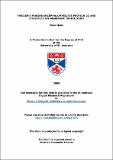Files in this item
Theiler's murine encephalomyelitis protein 2C and its effect on membrane trafficking
Item metadata
| dc.contributor.advisor | Ryan, Martin Denis | |
| dc.contributor.author | Moës, Elien | |
| dc.coverage.spatial | xvi, 189 p. | en |
| dc.date.accessioned | 2008-10-24T14:56:40Z | |
| dc.date.available | 2008-10-24T14:56:40Z | |
| dc.date.issued | 2008 | |
| dc.identifier | uk.bl.ethos.552173 | |
| dc.identifier.uri | https://hdl.handle.net/10023/540 | |
| dc.description.abstract | Picornaviruses replicate in association with cytoplasmic membranes of infected cells. Poliovirus 2C and 2BC play an important role in the formation of membranous vesicles, and induce dramatic changes in membrane trafficking. Theiler’s murine encephalomyelitis virus protein 2C was localized in infected cells using an anti-TMEV-2C antibody. Early upon infection, TMEV 2C was localized in the cytoplasm in an ER-like pattern. At later stages, 2C redistributed to a juxtanuclear site, which represents the viral replication site. Co-localization with the Golgi complex could not be observed. TMEV 2C seems to interact in vitro with reticulon 3, a highly conserved ER-associated protein. It was not possible to confirm a previously identified interaction with AKAP10, a protein kinase anchoring protein, presumably reflecting conformational constraints of the interaction. Two mutations in the AKAP10 binding site of TMEV 2C were identified, which inhibit the completion of the infectious cycle of TMEV. The intracellular changes that occur during TMEV infection were observed. Both actin filaments and microtubules may be used at early stages of infection; however both cytoskeleton components accumulate at the periphery of the cell during late stages of infection. A computer- based analysis has demonstrated that TMEV 2C is highly similar to katanin, a microtubule- severing protein, and may play a similar role in the reorganization of microtubules during infection. The Golgi complex turns from a solid, crescent-shaped organelle, into a series of punctuate fluorescent points forming an expanding balloon-like structure surrounding the concomitantly expanding site of virus replication. The remnants of the Golgi complex are finally dispersed throughout the cytoplasm. Live imaging confirmed these findings. It was observed that PKA also undergoes displacement to the cell periphery during infection. However, BIG1 seems to locate to the viral replication site during infection, suggesting it may play a role during viral replication. The localization of PKA and BIG1 in the infected cell may in part explain the observed dispersion of the Golgi complex. | en |
| dc.format.extent | 7900200 bytes | |
| dc.format.extent | 4682154 bytes | |
| dc.format.mimetype | application/pdf | |
| dc.format.mimetype | video/mpeg | |
| dc.language.iso | en | en |
| dc.publisher | University of St Andrews | |
| dc.rights | Creative Commons Attribution-NonCommercial-NoDerivs 3.0 Unported | |
| dc.rights.uri | http://creativecommons.org/licenses/by-nc-nd/3.0/ | |
| dc.subject.lcc | QR410.2E55M7 | |
| dc.subject.lcsh | Polioviruses | en |
| dc.subject.lcsh | Viral proteins | en |
| dc.subject.lcsh | Biological transport | en |
| dc.title | Theiler's murine encephalomyelitis protein 2C and its effect on membrane trafficking | en |
| dc.type | Thesis | en |
| dc.type.qualificationlevel | Doctoral | en |
| dc.type.qualificationname | PhD Doctor of Philosophy | en |
| dc.publisher.institution | The University of St Andrews | en |
This item appears in the following Collection(s)
Except where otherwise noted within the work, this item's licence for re-use is described as Creative Commons Attribution-NonCommercial-NoDerivs 3.0 Unported
Items in the St Andrews Research Repository are protected by copyright, with all rights reserved, unless otherwise indicated.


